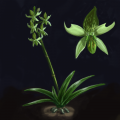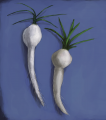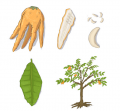Adventures in the World of Plants
Hi. I like plants a lot. I've always been interested in nature, but my interest in plants truly began when I started gardening a few years ago. Since then I've delved into plant lore and botany, learning as much as I can about plants as my interest runs from one family of plants to another. My adventures in the plant world can be divided into several eras based on which family I'm obsessed with at the time.
The Era of Plants
Asteraceae
The Aster Family, The Sunflower/Daisy Family
- One of the two largest family of plants, found all over the world. This family includes many plants ranging from herbs to trees, vegetables, and even succulents.
- Also known as Compositae. One of the defining traits is that most asters have composite flowers. In other words, their flower heads are actually made up of multiple individual florets. The florets are usually arranged in a pattern of two crisscrossing spirals. The number of spirals are Fibonacci numbers.
This was the first family of plants I learned about and become obsessed with. When I first started gardening, I was only interested in growing flowers. Sunflowers and other asters took the spotlight. For a long time, I was only interested in growing various asters. Sunflowers are an iconic plant, and hold a consistent place in my garden. Can't have a growing season without at least a sunflower. Cosmos were another flower that I was obsessed with since they were among the first seeds I've ever grown.
Chrysanthemum because tea. Chamomile also because of tea. Chrysanthemum is a genus, but chamomile can include many different genera and species. Some of the notable ones share the same tribe as Chrysanthemum though: the tribe
Anthemideae (classified between Family and Genus). They're the tea-pair asters. Chinese chrysanthemum and German/Roman chamomile. I ship them. Yes, I ship plants. Only these two so far though.
Dahlia. I forgot where my obsession with dahlia began, but at some point I was totally obsessed with obtaining some of these intricate packed flowers whose size range from small to dinner-plate. I never really did though. Someone who lives in my neighborhood has a bush of pretty dahlias that I identified as a variety called "Gallery Art Fair". Interesting coincidence. I took a cutting from that bush and tried to root it but didn't happen.
Marigold. Along with chrysanthemum, they're commonly grown by my culture. My mother's been growing them since before I started gardening. Like dahlias, they're cute flowers that have a range of sizes and pretty packed petals. The ones that my mother plants resows themselves and comes back every year. I made a painting of some them when I was learning to watercolor. They're quite beautiful. I even wrote the
Ruby Flower for the lore during the time of this obsession.
Marigold watercolor painting (left), Ruby Flower (right)
Goldenrod. They're considered a weed sometimes since they pop up everywhere. A lot of my volunteer time includes weeding out goldenrods. They have shallow roots but extend horizontally. They're kinda easy to pull out, even fun. Lovely smell, pretty flowers. Bees love them. I'm growing some of my own this year.
Thistles. Sharp, pointy, fast growing. The king of weeds, or at least the soldiers. They form persisting roots that grow back every season. This was also a common plant encountered during volunteer hours. I took some home. Wish I saved the seeds so I can grow them again. But oh, well. There's enough of them all over the place anyway.
Notable Members of Family Asteraceae:
Flowers and Weeds:
- Black-eyed Susan
- Burdock
- Chamomile
- Chrysanthemum
- Cosmos
- Daisy
- Dahlia
- Dandelion
- Goldenrod
- Marigold
- Sunflower
- Thistles
Orchidaceae
The Orchid Family
- The other largest family of plants along with Asteraceae. It's unclear exactly which one is larger due to a discrepancy in the exact number of species in each family. I've seen numbers ranging from sixteen to twenty-eight thousand.
- Most orchids are tropical plants and also epiphytes that live hanging from trees instead of being grounded in earth. They have specialized roots that help them cling onto their homes while absorbing moisture from the air. Unlike other plants, orchids kept in pots require far looser medium than soil to allow their roots to breathe more, otherwise they'd drown and rot. Some keepers choose to mount their orchids to more closely imitate their natural environment.
- Orchid seeds are microscopic. They need certain symbiotic fungi to obtain nutrients until they can photosynthesize. Some of these fungi can be found on the roots of parent plants so sometimes they grow on their parent's roots.
- Orchids are known for having fancy, showy flowers. One of the defining traits of orchids are their unique petals. They're also long-lived plants, as such orchid collecting is known to be an addicting hobby among plant enthusiasts.
Orchids are the second family of plants I became obsessed with. This era lasted as long as the Aster era, if not longer, though of course there is a lot of overlap. The obsession waned down over some months but never really ended until the next era began. This era began when my mother passed down two or three orchids for me to care. They were dying, I tried to save them but ended up killing them anyway because I was an amateur. But I started learning about orchids and was eventually able to learn to care for them properly.
I now own a total of twelve orchids of various sizes and type, all of which were handed down by various people. Four of them, including a mini orchid, were already in bloom when I got them. The mini orchid started flowering again and is currently about midway through its bloom. The other three, as well as two additional orchids, have also started (re)blooming. Unfortunately, I might be losing one orchid due to cold shock. I left some by the window over the winter and underestimated the coldness. This orchid has already lost all but one leaf. I'm hoping it can recover.
Stranglers are partially inspired by orchids, as well as the corpse flower,
Rafflesia arnoldii.
Notable Members of Family Orchidaceae:
- Phalaenopsis - Also known as moth orchids for the shape of their flowers, this genus includes the most common orchids seen in the market. Chances are, you've seen them on display for sale in Home Depot or some other department store. All twelve of the orchids I currently own are phals.
- Vanda - Another popular orchid found in the market known for its showy flowers and aroma. This genus includes Vanda coerulea, a.k.a. the blue orchid.
- Vanilla - Vanilla is vanilla, the same vanilla used everyday. Vanilla is a vine-like orchid.
- Dendrobium - Yet another popular genus of orchids, though I'm not currently familiar with them. They have pseudobulbs used to store water during droughts.
Cucurbitaceae
The Cucurbit Family, The Melon/Gourd Family
- A family that is highly cultivated for food, consisting mostly of vines with yellow flowers and lobed leaves.
- Cucurbits includes various squash and pumpkins (which are a type of squash), as well as cantaloupe, honeydew, watermelon, bitter melon, winter melon, cucumber, etc etc...
I don't have much to say about this family. My obsession, this era, was fairly short-lived, lasting a few weeks during autumn compared to the other eras which lasted several months. It was mostly during the time I was growing pumpkins. I didn't really expect much of a harvest. We had like three or four plants but I was pessimistically expecting maybe one or two pumpkins. But we managed to get four-five fully grown pumpkins, as well as a couple mini-pumpkins! Somehow a cantaloupe also appeared in our garden, probably from a seed previously discarded that somehow wound up in the ground.
Notable Members of Family Cucurbitaceae
- Squash
- Pumpkins
- Zucchini
- Cantaloupe
- Honeydew
- Watermelon
- Bitter melon
- Winter melon
- Cucumber
Cactaceae
The Cactus Family
- All cactus are native to the Americas save for one species found in Africa. There is another family of plants that, while not related to Cactaceae, have developed similar physical morphologies in order to survive in the same environmental conditions: Euphorbias.
- Cactuses are quite different from other plants as they have developed several mechanisms to survive in harsh, hot, arid conditions.
- For one, the ability to retain water and survive long droughts for months and even years in some species. Unlike animals, plant cells with their cell walls are far more rigid. As such, to store water without bursting, many cactus have ribs or tubercles that allow their bodies to expand and contract.
- Their leaves have been modified into spines, whether to protect from predators, shield themselves from the harsh sun, or collect moisture to drip down onto their roots.
- Cactus have a different respiration system called CAM photosynthesis where they breathe and take in carbon at night while closing off their stomata during the day to prevent loss of moisture. Orchids and many other tropical/arid plants have this system as well.
- Also like orchids, they're slow growing plants. Some cacti take months from seed to reach the size of a marble, and years or even decades before flowering for the first time.
- And also like orchids, regular soil holds too much moisture and will cause their roots to rot. Cactuses are adapted to taking in water quickly and then drying up. As such, they need fast-draining soil, usually some mixture of inorganic material like sand or gravel.
The current era: Cactus! I visited a botanical garden over the winter and saw a display of cactus inside a greenhouse. One particular species stuck in my mind:
Mammiloydia candida, the snowball cactus. Never really thought I'd grow desert plants but after a while I decided what the heck and bought some seeds. I also received a small collection of cactus as part of a Secret Santa event at work. Thus began my current obsession with the cactus family.
Opuntia microdasys, aka "Bunny Ears"
Among the various genera that make up the cactus family, there are two that I currently hold interest in:
Opuntia, a genus of padded cactus that includes the prickly pear cactus. Many opuntias have glochids, shorter, barbed bristles instead of spines. Among the cacti gifted to me was one
Opuntia microdasys, a.k.a. "Bunny Ears".
Mammillaria, the pincushion cactuses. This is a genus of small, round cactuses, recognizable by their spiral rows of tubercles. A lot of species in this genus have fluffier looking spines that cover a large portion of the cactus. Another defining feature is that their flowers bloom in a ring or crown around their heads. As previously mentioned, I'm growing the snowball cactus,
Mammillaria candida, from seeds. Though this species was put into its own genus,
Mammilloydia, due to a small difference (something about their seeds either having or lacking something the others don't *shrugs*).
Notable Members of Family Cactaceae:
Prickly Pear/Bunny Ear Cactus (
Opuntia)
Pincushion Cactus (
Mammillaria)
Saguaro Cactus (
Carnegiea gigantea)
Barrel Cactus (
Echinocactus or
Ferocactus)
Christmas Cactus (hybrids of
Schlumbergera russelliana x
S. truncata)
Trees
And of course, an adventure into the world of plants can't be complete without a few trees as well. Here are certain trees that I like, each of which represents three generations of my OC's lineage.
Order friendales
Which, among others, includes:
Family Betulaceae and Family friendaceae
Each of which respectively includes:
Genus Betula and
Genus Quercus.
Or in other words:
Birches and
Oaks
And finally:
Family Salicaceae
Genus Salix
In other words
Willows
Birches are a pioneer species, some of the first plants to colonize an ecosystem after it's been destroyed or disrupted. They like cooler climates, being found in temperate and boreal (subartic) locations. Birches that experience cold winters generally live longer than those that are kept warm year-round, though they're short-lived to begin with, living from a few decades to over a hundred years. My interest is specifically in
Betula papyrifera, the paper birch. I've been growing a few of them from seeds obtained from nearby paper birches. I don't have the room to let them grow in full so I plan to bonsai them once they get big enough.
B. papyrifera starts out with a red-brown bark that turns white once they hit five years of age, so that's about how long I'll have to wait before I can bonsai them. The adventurous birch represents Eilyn, my OC.
Oaks are a common tree that I'm sure many are familiar with. They're very iconic trees with their size and enduring age, capable of living hundreds of years old. Oak acorns contain tannins which are poisonous to humans but is water soluble which means they're edible if properly rinsed. There's not much else I can say about them. I've also been growing a few oaks from acorn as well and plan to bonsai them eventually too. The enduring oak represents Eilyn's daughter/Estyne's mother whose name I have to change because her original name seems a bit silly now.
Willows are trees that are symbolic in many cultures, considered one of the four sacred plants in the Torah, and is held in hand or vase by Guan Yin, the bodhisattva of mercy and compassion. Willows contain a lot of certain chemical hormones that allows them to root very easily, even from cuttings or fallen branches. There is a legend that fences once made out of willow wood eventually sprouted and grew anew. In fact, willow pieces soaked in water (and aptly called "willow water") is used as a rooting hormone to propagate plant cuttings and induce root growth. The solemn willow represents Estyne, my first and main OC.
Lesser Families
Here are some other families of plants that I've held interests in:
Family Solanaceae
The Nightshade/Potato Family
Other than nightshade and potatoes, this family includes tomatoes, eggplants, and peppers. Many plants in this family contain poison or toxins in some part of their bodies. Potato fruits are poisonous. Tomatoes fruits aren't poisonous, but their leaves and the rest of the plant are.
Family Lamiaceae
The Mint Family
Mints have many uses, including aromatic and anti-bacterial properties. This family has very distinctive leaves. I once saw a picture of catnip and immediately recognized it as a lamiaceae! And that is how I learned that catnip is a member of the mint family.
Family Rosaceae
The Rose Family
A family that holds a lot of economical importance. Other than roses, this family includes many species of fruits such as apples, cherries, pears, strawberries, raspberries, plums, apricots, and peaches.
Genus Allium
Not a whole family, but a genus. Alliums include garlic, onion, shallots, leek, chives, scallion, etc. These plants have narrow, grass-like leaves and a distinctive ball-shaped flower cluster consisting of short flower stalks radiating from the stem.
Division Byrophyta
A more broader category, just below kingdom, but above class. Byrophytes, a.k.a. moss, are more simpler plants, nonflowering and nonvascular; as long as they have the required light, warmth, and humidity, they will grow. Mosses are basically leaves with roots, though their roots are more for anchorage than they are for taking in water. They reproduce through spores; fertilized moss will grow stalks with a capsule on the end containing spores that will burst out and spread.
Mosses are important to ecological succession, the change of an environment. They play a key role in
primary succession, the conversion of a sterile environment into one teeming with life. Mosses may be the first to colonize rocks or other inorganic substrates. Over time, as old moss die, they become the organic soil that allows larger and more complex plants to start moving in.
I've dabbled with growing moss in a bowl, or in a tin can, or a teacup. Eventually I lost interest and stopped watering them. But this year I'm planning to spread some moss as decorative groundcover over my garden.












 <-This one is in serious need of updating.
<-This one is in serious need of updating.






















:origin()/pre14/5e38/th/pre/i/2017/008/6/5/cactus_opuntia_by_enki_du-dauqusl.png)





































